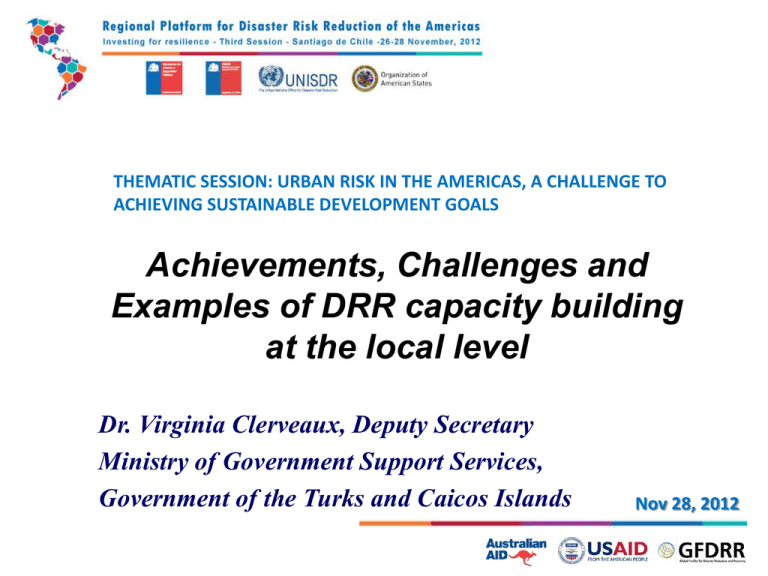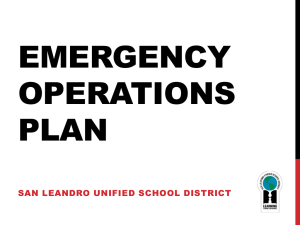Virginia-Clervaux
advertisement

THEMATIC SESSION: URBAN RISK IN THE AMERICAS, A CHALLENGE TO ACHIEVING SUSTAINABLE DEVELOPMENT GOALS Achievements, Challenges and Examples of DRR capacity building at the local level Dr. Virginia Clerveaux, Deputy Secretary Ministry of Government Support Services, Government of the Turks and Caicos Islands Nov 28, 2012 Presentation Outline • Disaster Risk Reduction - The Conceptual Framework • Examining Capacity Building • The Local Government Context; Capital Cities at Risk; Case Studies, Jamaica, Cayman and the Turks and Caicos Islands and Cuba. • Achievements and Capacities needed at the Local Level • Examples of Best Practices • The Way Forward, Strengthening Capacities at the Local Level THE CARIBBEAN Disaster Risk Reduction • The concept and practice of reducing disaster risks through systematic efforts to analyse and manage the causal factors of disasters, including through reduced exposure to hazards, lessened vulnerability of people and property, wise management of land and the environment and improved preparedness for adverse events (ISDR Glossary, 2008) Thematic Areas of Disaster Risk Reduction Governance •Policy and Planning •Legal and Regulatory Systems •Resources and Capacities •Institutional Mechanisms, Capacities and Structures Risk Assessment •Hazard Risk Data Analysis •Vulnerability and Impact Data / Scientific Innovation •Early Warning Systems Knowledge and Education Risk Management and Vulnerability Reduction Disaster Preparedness and Response •Information Management and Sharing •Education and Training / Learning and Research •Public Awareness •Environmental and Natural Resource Management / Climate Change Adaptation •Sustainable Livelihoods •Social Protection •Financial Instruments / Structural and Technical Measures • • • • Organisational Capacities and Coordination Preparedness and Contingency Planning Emergency Response Mechanisms Participation and Voluntarism Capacity Building • Efforts aimed to develop human skills or societal infrastructure within a community or organization needed to reduce the level of risk. Capacity-building also includes development of institutional, financial, political and other resources, such as technology at different levels and sectors of the society. (UN/ISDR, Words Into Action: A Guide for Implementing the Hyogo Framework, Switzerland, 2007, p. 153) Urban Risk: The Caribbean Context • • • • • • • • Geographical location (multi hazard perspective) Technological Risk Factors Historical evolution Primacy Socio-economic development Future growth Status of national DRM Disaster impact profile of Caribbean Capital Cities Local Governance Models in the Caribbean • Jamaica - Mayors; the Political Director in charge of Townships and Cities (Kingston Model). One directly elected Mayor – Municipality of Portmore • Turks and Caicos Islands – District Commissioners for less populated Islands (Appointed Civil Servants) Main islands managed by Central Government. • Cayman Islands - District Commissioners for Sister islands Main island managed by Central Government • Cuba – 14 provinces and 169 municipalities. Delegates to provincial and municipal assemblies directly elected. One special municipality- Isla de la Juventud Local Government Context • Natural hazards: an increasing concern for urban planners. • What drives disaster risk in urban settings? • Facts and figures Hazard Earthquake Urban Concerns •Densely built and populated cities lie on earthquake belts. •Non-engineered & poorly-built/badly-maintained buildings withstand the force of seismic shocks, are more likely to collapse. •Most earthquake deaths are due to building collapses. cannot Landslide •More people are exposed to catastrophic landslides, triggered by rainfall saturation or seismic activity due to: •Badly built or makeshift homes on/below steep slopes, on cliffs or at river mouths in mountain valleys, •Poor drainage or slope protection Volcanic Eruption •Settlements on volcano flanks or in historic paths of mud/lava flows put millions of people at risk. •Adequate early warning systems and constructions to withstand ash and lahar flows are concerns for urban and rural areas near volcanoes. Tsunami •Many cities have been built along tsunami-prone coasts. •Adequate construction, early warning systems and evacuation plans are primary measures to address these. What drives disaster risk in urban settings? 1. Location i. Hurricane Belt ii. Seismically active Region 2. 3. 4. 5. 6. 7. 8. Rising urban populations and increased density Weak urban governance Unplanned urban development Lack of available land for low-income citizens Inappropriate construction Concentration of economic assets Ecosystems decline GOVERNANCE KEY QUESTIONS CUBA CAYMAN JAMAICA TCI What structures are at the local level to drive DRR? Provincial and Municipal Assemblies and People’s Councils District Commissions Committees of Council, Community Development Committees (CDCs) District Commissions and Community based groups Level of Autonomy Heavily Influenced by Central Government Main islands under direct governance. In Transition as a result of Local Government Reform Main Islands under direct governance. Self Financing Dependent on Central Government. Limited capacity to implement proposals Dependent on Central Government Partial funding from Central Government Established Parochial Fund Dependent on Central Government GOVERNANCE KEY QUESTIONS Authority to establish commitments and to set measurable and verifiable goals CUBA CAYMAN JAMAICA TCI No Logical No Framework and Action Plan (Pilot) Disaster Risk Assessments KEY QUESTIONS Hazard Risk Data Analysis conducted at the local level? CUBA Established Risk Reduction Centres CAYMAN JAMAICA TCI Not at the local level Limited capacity in selected parishes Not at the local level Presence of Hazard Specific Maps to aid in the decision making process Available Available Available Available Early Warning Systems Flood Early Warning Systems Tsunami Warning Protocols Flood Early Warning Systems Tsunami Warning Protocols World renown for Evacuation Planning Tsunami Warning Protocols Best Practices • • • • • Leadership for Good Governance Political Champion – to drive policy (Jamaica) Community Disaster Management Structure established Risk Transfer Mechanism - Calamity Fund Strategizing - Logical Framework and Action Plan to ensure that the work is done. • Disaster Risk Management Integrated into the Local Developmental Approval Process-BVI, JA • Strengthening of DRR through Decentralization and Devolution processes Best Practice - Disaster Risk Reduction Centres, CUBA The Disaster Risk Reduction Centres aim to: • Facilitate analysis and periodic assessment of local risks and factors that produce vulnerabilities • Control the process and prepare information derived from surveillance and monitoring action • Participation in the preparation of territorial disaster reduction plans • Preserve historic memory of disaster even (Cuba Risk Reduction Management Centres, UNDP, 2010) BEST PRACTICE - GIS for Sustainable Development and Disaster Risk Management in Manchester (Parish), JAMAICA The Way Forward 1. Training Planners and other Technical Staff in Hazard Mapping and GIS to influence the Developmental Approval Process 2. Greater Autonomy at the Local Level to aid vulnerable communities 3. The Appointment of Political Champion-Greater political buy-in 4. Establishing Risk Reduction Centres – embed in Planning Departments. 5. Greater Partnerships with Universities and Research- Based Institutions 6. Education dimension 7. Comprehensive planning-preparedness & response 8. Mitigation-urban planning decision-building codes, code enforcement The Way Forward • Safety of urban centre-planning has to be good multi sector implication • Hazard-specific plans – note Earthquake contingency plan in vogue • Education dimension • Comprehensive planning-preparedness & response • Mitigation-urban planning decision-building codes, code enforcement • Technological hazard dimension of urban centres • Sheltering in cities • Evacuation of cities THANK YOU Dr. Virginia Clerveaux Email: vclerveaux@gmail.com/ viclerveaux@gov.tc Tel. 649-946-2801






